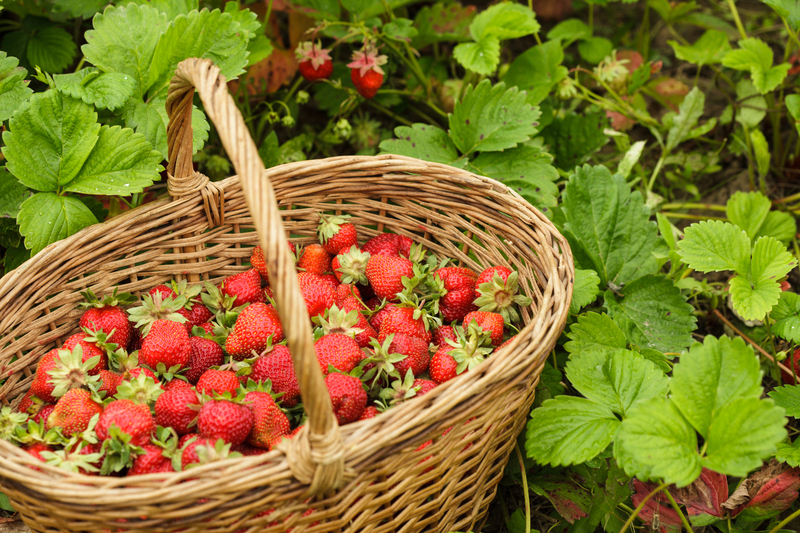Winter Garden Care: Keeping Plants Safe and Warm
Posted on 17/09/2025
Winter Garden Care: Keeping Plants Safe and Warm
As the chill of winter sets in, experienced and novice gardeners alike face the annual challenge of protecting their beloved plants from freezing temperatures, biting winds, and unpredictable weather. Winter garden care is essential to ensure your outdoor oasis thrives come spring. This comprehensive guide explores the best practices for safeguarding your garden throughout the colder months, offering tips on how to insulate, water, and shelter your green treasures.
Understanding the Importance of Winter Plant Protection
The arrival of winter doesn't have to signal the end of gardening season. Rather, it marks a critical period that can determine the health and success of your plants in the upcoming year. Protecting your garden during the cold months involves a combination of preparation, ongoing maintenance, and strategic interventions. Proper winter care ensures that your plants remain healthy, resilient, and ready to burst into life when spring returns.
Why is Winter Garden Protection Necessary?
- Frost and Freeze Damage: Sudden temperature drops can damage or kill tender plants.
- Dehydration: Cold weather can dry out soil, depriving plants of vital moisture.
- Pest and Disease Prevention: Unprotected plants are more susceptible to winter pests and diseases.
- Maximizing Spring Growth: Healthy plants in winter are more likely to thrive in spring.
Proactive winter garden maintenance helps mitigate these risks, preserving the investment of time and effort you've put into your garden all year.

Essential Steps for Winterizing Your Garden
Effective winter garden care involves several key practices designed to support plant health during cold weather. The following steps will help keep your plants safe and warm right through winter:
1. Assess Your Garden's Vulnerabilities
Start by identifying which plants need extra attention. Consider the following:
- Tender perennials, annuals, and young shrubs are most at risk from the cold.
- Plants in containers are more susceptible as their roots are less insulated.
- Plants in exposed or windy locations require more protection.
Make a list of these vulnerable plants to prioritize your efforts.
2. Clean Up and Prepare the Garden
Before the first hard freeze, thoroughly clean your garden:
- Remove dead or diseased foliage to prevent overwintering pests and pathogens.
- Cut back perennials, but leave some seed heads for birds and winter interest.
- Pull up annuals that have completed their lifecycle.
Tip: Compost healthy plant debris, but discard anything diseased to avoid spreading problems next year.
3. Mulching: Your First Line of Defense
Mulch insulates soil, conserves moisture, and helps regulate root temperatures. Apply a layer of mulch 2-4 inches thick around the base of your plants, especially over the root zones. Use materials like:
- Shredded bark
- Straw
- Compost
- Leaves (preferably chopped to avoid matting)
Mulching garden beds in winter can mean the difference between a thriving plant and one killed by frost heave or temperature swings.
4. Protecting Young Trees and Shrubs
Newly planted or young woodies are particularly at risk over winter. To safeguard them:
- Wrap trunks with tree wrap to prevent sunscald and frost cracking.
- Install stakes or windbreaks to prevent wind damage.
- Mulch generously around the base, but keep it a few inches away from trunks.
Remember to remove wraps and ties in spring to avoid restricting growth.
5. Shelter for Container Plants
Winter care for potted plants requires special attention. Containers provide little root insulation, so:
- Group pots together and place them in a sheltered spot, such as against a south-facing wall.
- Wrap pots with burlap, bubble wrap, or move them into an unheated garage or shed during extreme cold.
- Elevate pots off the ground to prevent waterlogging and freezing.
Insulated pots and pot feet are excellent investments for long-term winter plant safety.
6. Watering Wisely in Winter
It may seem counterintuitive, but plants need water in winter, especially evergreens, which continue to lose moisture through their leaves. Here's how to handle winter watering:
- Water thoroughly before the ground freezes, particularly for new plantings.
- During dry spells, water on mild days when soil is not frozen.
- Avoid waterlogging, as wet roots can rot in cold conditions.
Proper hydration helps plants fend off winter desiccation and supports them through dormancy.
7. Coverings and Cloches: When and How to Use Them
Extra insulation may be required during severe cold spells. The following covers can provide vital warmth:
- Row covers and garden fleece are lightweight, easy to use, and allow light and moisture through.
- Burlap or hessian is ideal for wrapping evergreens and shrubs.
- For individual tender plants, use a cloche or even an upturned bucket on frosty nights.
Always remove covers during milder periods to prevent overheating and fungal growth.
Special Tips for Different Plant Types
Winter Garden Care for Perennials
Most perennials survive winter by dying back to the ground. Still, a bit of extra care goes a long way:
- Cut back dead foliage once it is blackened by frost.
- Mulch roots well, especially for marginally hardy varieties.
- Mark plant locations to avoid accidental damage during spring clean-up.
Looking After Roses in Winter
Roses are susceptible to winter damage, especially hybrid teas and grandifloras. Protect them with these steps:
- Mound 8-12 inches of well-draining mulch, compost, or soil around the base after the first hard frost.
- Cover with burlap or a rose cone in regions with severe winters.
- Prune only diseased or damaged canes until spring, when corrective pruning can be completed.
SAFEGUARDING EVERGREENS
Evergreens add year-round beauty but face particular dangers over winter:
- Wind and sun can cause browning or desiccation. Provide windbreaks or wrap with burlap if necessary.
- Keep watering until soil freezes to prevent winter burn.
- Brush off heavy snow, but avoid shaking branches which can cause breakage.
Annuals and Winter Vegetables
While most annuals are finished for the year, cold-hardy winter vegetables, like kale, spinach, and carrots, can continue to produce with a bit of extra protection:
- Use cloches, cold frames, or thick row covers to extend the harvest season.
- Mulch root vegetables heavily, so they can be left in the ground and dug as needed.
Bulbs and Tubers: To Lift or Not to Lift?
Some bulbs, such as tulips and daffodils, can be left in the ground. Others, like dahlias and gladiolus, must be dug up in colder climates:
- Hardy bulbs: Mulch heavily after the ground cools to help regulate temperature and retain moisture.
- Tender bulbs: Dig up after foliage dies back, dry, and store in a cool, frost-free place until spring.
Common Winter Garden Challenges and Solutions
Even the most experienced gardeners face setbacks during winter. Here's how to tackle some of the most common winter garden problems:
- Frost Heave: Caused by the expansion and contraction of soil during freeze-thaw cycles, this can push plants out of the ground. Apply a thick layer of mulch after the ground begins cooling to prevent this.
- Rodents and Wildlife: Mice, voles, and rabbits may gnaw on bark and roots. Protect trunks with tree guards or hardware cloth and avoid piling mulch directly against stems.
- Salt Damage: Road salt and de-icing agents can damage nearby vegetation. Use barriers or choose salt-tolerant varieties for areas near driveways and paths.
- Snow Load: Heavy, wet snow can break branches. Gently remove snow as soon as possible, but avoid forcibly bending frozen limbs.
Winter Garden Care in Greenhouses and Indoors
For those lucky enough to have a greenhouse or indoor gardening space, winter still presents unique challenges and opportunities for plant care:
- Monitor temperature closely and use heaters or heat mats as needed to maintain safe levels.
- Watch for condensation and maintain good ventilation to prevent fungal diseases.
- Reduce watering frequency but do not let plants dry out completely.
- Provide supplemental lighting to counteract shorter days and promote strong, healthy growth.
Indoor gardens can be havens for tropical or tender plants throughout the year, but regular monitoring is key for pest and disease prevention.
Sustainable Winter Garden Practices
By using environmentally friendly methods, you can keep your garden warm and healthy while also protecting local wildlife and the planet:
- Use organic mulches and local materials whenever possible.
- Leave some leaf litter or brush piles for overwintering beneficial insects and small animals.
- Try not to disturb soil unnecessarily, as this protects hibernating pollinators and maintains soil health.
- Choose hardy, native plants to reduce the need for energy-intensive interventions.

Planning Ahead: Spring Preparation Begins in Winter
Caring for your garden in winter isn't just about survival - it's also about setting the stage for robust spring growth. Here's how you can prepare:
- Order seeds and supplies early, as demand can be high come spring.
- Sharpen and clean tools so you're ready when planting season arrives.
- Prune deciduous trees and shrubs during dormancy, avoiding spring bloomers which form buds on old wood.
- Monitor for early growth and remove mulch gradually when temperatures begin to rise.
Consistently checking on your garden throughout winter allows you to catch issues early and keeps you connected with your plants even in the quietest months.
Conclusion: Nurturing Your Garden all Winter Long
Winter garden care is an act of patience and dedication. By preparing your plants for cold weather, providing strategic insulation, and continuing to monitor them throughout the season, you ensure a vibrant garden that will reward you tenfold in the coming year. With these comprehensive winter gardening tips, your plants will stay safe and warm, ready to welcome the first signs of spring.
Remember, every garden is unique. Adjust your approach based on your local climate, the specific needs of your plants, and the lay of your land to keep your winter garden protected and thriving.
Start your winter garden routine today, and give your plants the care they need to survive and flourish--no matter how low the temperatures fall!

